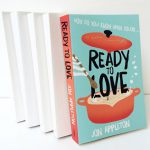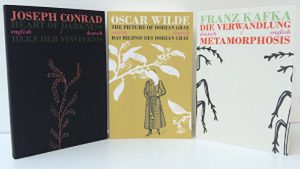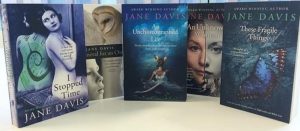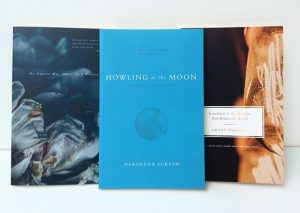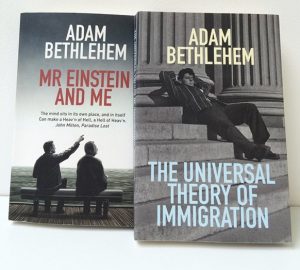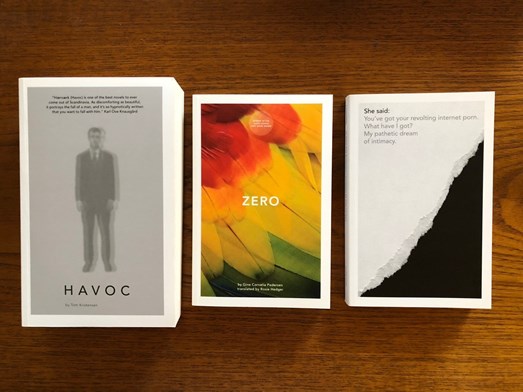
Founded by the lovely Duncan Lewis, Nordisk Books is a London based independent publisher that focuses on contemporary Scandinavian literature. They first printed with Clays back in 2016 with their first title Havoc by Tom Kristensen, and have since gone on to print and publish a further two books with another out soon! We caught up with Duncan about why he decided to start his publishing venture and the importance of literature from Scandinavia …
What was the inspiration behind Nordisk Books and what drew you to Scandinavian literature?
I spent six years living in Denmark, which is my main connection to the region. I’ve always loved the landscapes of the Nordic region and have spent a lot more time in the Faroe Islands, Iceland, Finnish Lapland etc. than the Costa Brava. I obviously got started reading some of the local literature when I was in Denmark, but really became more passionate about it later, after I left and wanted to maintain a connection to the region.
How do you choose what books you publish, and what is it about their work that catches your interest?
Well I keep up with a large number of the Nordic publishing houses, both major and indie, via their social channels, so I can see what they are currently promoting and that gives me ideas. Especially for the languages I can read myself (ie Danish, Norwegian and Swedish), this means I can ask for copies from those publishers and have a view on them directly. Plus I’ll try and go to at least the London and, for obvious reasons, Gothenburg book fairs and meet as many publishers as possible there, to exchange ideas – also those in other countries who are publishing Scandinavian fiction, like Iperborea in Italy.
We hear a lot about Scandinavian crime and thrillers – do you think literary fiction from this region is overlooked?
I think that, compared to crime and thrillers, literary fiction is overlooked in general. It’s interesting how books that are not necessarily ‘easy reads’ have recently transferred with huge success to the small screen – just look at the Handmaid’s Tale or the Patrick Melrose sequence – and that this in turn generates large sales, but these were not books that were necessarily in prominent positions in your local Waterstones prior to their TV adaptations. People are interested in high quality fiction, from any language, it’s just up to the large publishing houses to choose what they wish to promote.

How important is fiction in translation to the UK literary landscape?
Very! Whilst translated works still make up a pretty small percentage of all books sold in the UK (the famous ‘3%’ has now crept up to around 4%), in literary fiction there have been some big titles in recent years that have done hugely well (Ferrante, Knausgård etc) that are leading the way. Additionally, there have sprung up a number of independent publishers with a focus on more unique works of fiction, so it’s not just Nordisk Books bearing the flag.
What is the main difference between a good translation and a bad translation?
It is remarkably easy to spot a bad translation when reading one, and remarkably hard to put into words why it is bad. If you are translating a Hayes manual, the only thing that really matters is to ensure that the reader can understand what he or she needs to do with the brake fluid or whatever. A literary translation is very nuanced, as the translator needs to understand the linguistic, cultural, historical and social context that the work comes from. I’ve been very lucky in the translators I’ve worked with so far – maybe it helps that they know I can read the original text.
The brand identity for Nordisk is brilliant and you can spot a Nordisk book – how did you come up with your branding and cover designs?
Too kind! I wanted something that would be clean and inspired by a minimalist aesthetic, but still allow for variety between titles. The Gallimard books, for example, look fantastic lined up on a book shelf, but I think I’d miss the ability to integrate more of the book’s identity into its cover design. I’m also very fortunate to be able to work with a friend who is an excellent designer.
Why did you decide to do print books? And how have you found the production process?
Personally I like the tactile nature of print books. I’m not one of these people who hates Kindles, I do see the use in the device and actually find it quite an enjoyable way to read, especially the lightness of the device, but there is something uniquely pleasurable about the feel of a new paperback. The production process is always a bit of a stressful time, as until the first box of books lands in the office, I don’t know quite how they will have turned out. But so far all the books have looked fantastic and it’s been one of the biggest sources of enjoyment of the whole project, to get my hands on those first copies.
Why choose Clays?
The structure at Clays whereby you have a focus on small publishers such as Nordisk Books is really helpful for those of us who come from a non-publishing background and need a lot of help, especially in the beginning. The mysteries of the printing process have slowly started to reveal themselves over the last two years!
What is your top advice to any small independent presses thinking about moving into print?
It’s not easy, as the profit margins are very small and you are competing with the behemoths of the industry for shelf space. But I think it’s worth it, I can’t imagine having a publishing house without print books, personally.
What is coming up for Nordisk?
We’re currently furiously planning the launch party for the next title, Zero, by Gine Cornelia Pedersen (out July 31st). After that there are two books already signed up and being translated as we speak, which I still hope to get out by the end of the year. I’m now starting to consider titles for 2019. I feel that it will be a ‘proper’ publisher when the list is in double figures, so that’s the medium term goal for now.
You can follow Nordisk Books on Twitter or find them on at their website!
